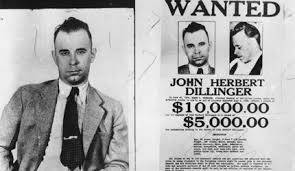I’ve always been fascinated with the story of John Dillinger – Hoosier Boy gone bad. It’s fascinating how criminals like Al Capone and John Dillinger have somehow become heroic legends. It was interesting to see “Dillinger Days” promoted during our recent visit to Tucson, Arizona, celebrating the 85th anniversary of his capture there and the 25th anniversary of the event. He and his gang were arrested after leaving a generous tip with a fireman who helped them carry their loot-filled luggage from a fire at the downtown Hotel Congress. He was Public Enemy #1, and the $12 token of their appreciation raised suspicion. It was after all the equivalent of over $200 in today’s money market. Dillinger was surprised by his notoriety, having traveled to this sunny location well off the beaten path from his prominently Midwest crime sprees. “I’ll be damned” was his reaction to the arrest.
He was soon extradited by airplane to his home state of Indiana, but escaped from a Crown Point prison while awaiting trial armed with a hand-fashioned wooden handgun. He had a non-violent reputation, using tricks like this to earn public support. Dillinger robbed banks, very unpopular in the Great Depression – not people. As a result, he was not seen as a threat by the average citizen and became a celebrity. They wanted to believe that her would never hurt anyone who was not shooting at him. He dressed well, was polite, never used foul language, drove fancy, high-powered automobiles, had a sharp wit, and eluded capture to ultimately be as much admired as Robin Hood. Also, his life style at a time of widespread poverty was enviably exciting to many, although he spent nine years in prison.
Dillinger was an Indianapolis, Indiana native who grew up in the town of Mooresville. Although, as a fellow Hoosier, I’m familiar with his legendary antics, I was not aware of his connection to Tucson. On our way to the airport, we stopped for breakfast with a college friend who mentioned that the Congress Hotel was just down the street and pointed out the historical sign:
“The venerable Hotel Congress, designed by well-known architect, Roy Place, is the last surviving historical hotel in downtown Tuscon. This three-story landmark was built in 1919 with exposed masonry construction and marble details. The hotel, south of the railroad depot, was convenient to railroad passengers arriving in Tucson. The elegant lobby and dining room provided a degree of refinement for winter visitors on their western adventure. A January 1934 fire destroyed the original third floor and inadvertently resulted in the capture of John Dillinger and his gang several days later. The Hotel Congress and the Rialto Theatre defined the east end of the commercial district on Congress Street.”
John Dillinger died of five gunshot wounds on July 22, 1934 at age 31, outside the Biograph Theater in Chicago, tricked for reward money by “the woman in red.” This was only 6 months after his arrest in Tuscon. In the meantime, he had returned to his father’s Indiana farm and was given a warm Hoosier welcome, a picnic, and posed for a picture in a three-piece suit, with no one anxious to arrest him. Three months after his death, one of his most famous gang members, George “Baby Face” Nelson was also killed by federal agents. He was not a Hoosier…but another boy gone bad!
As a side note, other known Hoosier Bad Boys from Dillinger’s gang included Homer “Virgil” Van Meter from Ft. Wayne, Indiana and Harry “Pete” Pierpont born in Muncie, Indiana. In a series of bank robberies from September of 1933 to July of 1934, the gang killed 10 men and wounded 7 more. Also, during three jail escape attempts, a sheriff was killed and two guards were injured. Still want to make him a Hoosier hero?

Leave a Reply